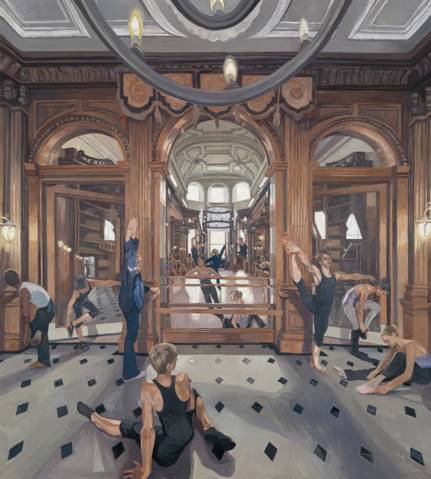John Wonnacott
dal 1/2/2011 al 24/2/2011
Segnalato da
1/2/2011
John Wonnacott
Agnew's Gallery, London
A solo exhibition of leading contemporary figurative painter John Wonnacott, A Tale of Two Houses. The show comprises an entirely new body of the artist's work and demonstrate his recent focus on fresh themes.

Agnew’s is pleased to announce its fifth solo exhibition of the work of leading contemporary figurative painter John Wonnacott, A Tale of Two Houses. The show will comprise an entirely new body of the artist’s work and demonstrate his recent focus on fresh themes. A Tale of Two Houses sees Wonnacott stepping away from his more familiar subject matter of family, local friends and the Essex coastal landscape, and firmly establishes his interest in the formal and lyrical aspects of dance, choreography and the filmmaking process. The exhibition will also include recent drawings, including three made during his spell in hospital in 2010 following major heart surgery, as well as several small still life paintings from the previous year. The artist’s carefully-arranged depictions of meats, cheeses and wine seem wittily prescient given his subsequent “brush with mortality”, which may have resulted from a self-confessed “fifty-year diet of alcohol and cholesterol.”
Wonnacott’s ‘dance’ paintings form one focus of A Tale of Two Houses, and depict ballet dancers in rehearsal against the richly baroque backdrop of an interior at Tring Park in Hertfordshire. Inspired by the vocation of his son Jack, currently in training as a professional classical dancer, Wonnacott embarked upon this series with the intention of exploring the parallels between musical rhythm – as conveyed by the movements of his dancing figures – and the artist’s rhythms of brushwork and colour. The subject of dance in relation to painting is further explored in the exhibition catalogue, in a fascinating conversation between the artist and the preeminent philosopher A. C. Grayling, in which Wonnacott describes his role in the making of the ‘dance’ paintings as that of “choreographer”.
A Tale of Two Houses also sees Wonnacott observing the making of producer Stephen Evans’ forthcoming film First Night (whose other films include The Madness of King George) – starring Richard E. Grant and Sarah Brightman – which follows an amateur production of Mozart’s Così Fan Tutte and the exploits of its cast. Manderston, a great Edwardian house in the Scottish Borders, acts as a stage set for both Evans and Wonnacott, and the artist’s resulting series of compositions – in which images of booms, cranes, cameras and scaffolding dominate the landscape – appears to emphasise the enduring theatricality of Manderston’s formal gardens, classical facades and ornate interiors. The nature of Wonnacott’s craft meant that, unlike a filmmaker, he was unable to follow themes, characters or changing light conditions through ‘linear’ time, but had to compact all of his responses to scenes at Manderston into single images. Beginning with a simple landscape, Wonnacott would proceed to incorporate aspects of the film company’s industrious chaos, thus animating and energising the original setting he had created.
The accompanying exhibition catalogue contains a selection of short essays written by Wonnacott on the relevance of perspective, dance and film to his craft. The catalogue’s transcript of extracts from Wonnacott’s conversations with A. C. Grayling answers the artist’s plea “to have my own confusions examined by what I consider the clearest mind currently broadcasting and writing in Britain” and, for Wonnacott, “are a reminder of the longer conversation that I will treasure and feed off for years to come.”
For further information and images please contact Rachel Phillipps or Kathryn Hone at PagetBaker Associates:
Tel: 0207 323 6963 / Email: rachel@pagetbaker.com Kathryn@pagetbaker.com
Opening 2 February 2011
Agnew's Gallery
35 Albemarle Street, London
free admission



